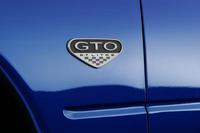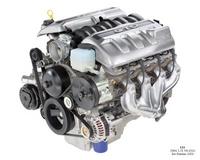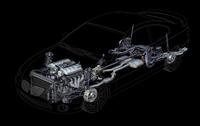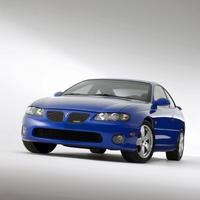Pontiac GTO History and Trivia Plus New 2004 Pontiac GTO Review By Cary Russ
DRIVING DOWN THE ROAD
WITH CAREY RUSS
The most revered three letters among the Pontiac faithful are ``GTO,'' and for good reason.
Forty years ago, when a 389 cubic inch V8 was dropped into a compact Pontiac Tempest Le Mans, the original Pontiac GTO launched the muscle car genre. It was an immediate American performance icon that lasted until the beginning of the automotive dark age at the end of 1973. From time to time since that sad date, rumors of a GTO revival have surfaced, but they have only been rumors. Pontiac had no platform that could do justice to the GTO name.
After the GTO's end, the V8 muscle performance niche at Pontiac was filled by the Firebird. But the Firebird was discontinued after 2002, leaving GM's ``Excitement Division'' with no rear-wheel drive, V8-powered excitement. It seems that at that point, someone in Detroit took inventory of the vast GM worldwide catalog of cars, and hit pay dirt. There was a car that, with only minor modification, could be made to work in America. It had the right specs, and then some: A powerful V8 engine in front, driving the rear wheels in a two-door unibody chassis featuring fully-independent sport-tuned suspension. This was something far more sophisticated than the old Firebird, and it had a reputation in its home territory as revered as the GTO did here.
That car was (and is) the Holden Monaro. The size and geographic isolation that have given Australia unique animals have also given it unique automobiles that have survived extinction elsewhere. King of the Monaro line is CV8, powered by a 5.7-liter V8 engine. Does this sound like the recipe for a modern muscle car? Does this sound like the car closest to the original GTO in the worldwide General Motors lineup? Indeed... but use in the U.S. would be subject to its meeting emissions and safety requirements, and also minor details like conversion from right-hand to left-hand drive. All of these problems were solved, and, with a minor change of clothes, the Holden Monaro has come to this country as the 2004 Pontiac GTO.
I've been driving one for the past week, and to say that I am very impressed is understatement. It compares favorably in ride and handling to some European sports coupes that cost twice as much. Fit and finish are also first-rate. Yes, it's less refined than the expensive Europeans, but some of that was undoubtedly intentional - too much civilization does not a muscle car make. And on the practical side, it holds four adults in comfort, something that could never be said of the Firebird. The GTO legend not only continues, but is enhanced by the 2004 model.
APPEARANCE: Body cladding and extraneous scoops and vents are gone from the Pontiac design repertoire. The GTO is the antithesis of the Firebird in style, with none of the Firebird's action-hero scoops and vents and bulges. Visually, it is very low-key, and almost invisible in traffic, with a high stealth factor. This is very, very good for a car with its performance potential. The smoothly curved lines are pleasing and very European, and attract attention only from those who know.
COMFORT: Space efficiency in a high-performance car? Believe it. The GTO has a 2+2 seat layout. This usually means two adults and two small children or suitcases. Here it means four six-foot adults, although the two-door body will make rear seat access a minor exercise in contortion. The front seats are well-bolstered, power-adjustable sports buckets with perforated leather upholstery, and the rear two are nearly identical except for a lack of adjustment and more (yes, more) cushion padding. Color-matching of instrument faces and interior panels with the exterior color is a very stylish touch. Despite the comfort, the GTO is a serious driver's car, and the driver gets first-rate instrumentation and controls in a contemporary instrument panel that is a mirror-image of the Monaro's. The steering wheel adjusts manually for both tilt and reach, and the shift lever is placed well. Steering, clutch, and pedal efforts are appropriately high, given the power on tap, but not excessive. The trunk is small, but still far larger than a Firebird's.
SAFETY: Pontiac's awesome Aussie meets all U.S. safety requirements, obviously, and also has strong four-wheel antilock disc brakes and an emergency system that automatically shuts off the engine, turns off the fuel pump, and unlocks the doors when an airbag is deployed.
ROADABILITY: Any nostalgia in the new GTO pertains only to the name. Only the front-engine, rear-wheel drive chassis layout is shared with its namesake. The unibody chassis is very rigid, and the suspension is fully independent, with MacPherson struts in front and a semi-trailing arm design in the rear. Spring and shock calibration is firm, very firm, but not punishing, and the huge P245/45 ZR 17 tires stay in contact with the road well for maximum traction and cornering force. It's a blast in the corners, and still reasonably comfortable on the highway. This is a real everyday car, not just a weekend toy.
PERFORMANCE: If the 2004 GTO's engine is smaller than the 1964 version's at 346 cubic inches to 389, it is more powerful. The new one is the aluminum LS-1 V8, rated at 350 horsepower at 5200 rpm. The original's 348 horses were a gross rating, and probably closer to 300 hp by today's methods. And today's street tires, as found on the `04 GTO, are far better than 1964 vintage racing tires, let alone street tires, for getting power to the ground. Although some post-1964 GTOs had truly gigantic engines, and may beat the new one in a straight-line quarter mile, today's GTO is balanced in a way that was impossible 40 years ago. Excellent acceleration is complemented by equally excellent deceleration courtesy of large four-wheel antilock disc brakes. Forty years ago a ``four-on-the-floor'' was the hot setup; add two more gear ratios now, with both fifth and sixth being overdrives for lazy, economical highway cruising. The 6-speed is optional, but highly recommended as it improves both performance and fuel economy compared to the standard four-speed automatic. A standard limited-slip differential also helps get 350 horses and 365 lb-ft of torque to the road, and traction control keeps the rubber on the tires.
CONCLUSIONS: Ah, Australia. The land where monotremes, marsupials, and muscle cars have survived has given us the 2004 Pontiac GTO, a serious muscle car with sophistication unknown to the 1960s.
SPECIFICATIONS 2004 Pontiac GTO Base Price $ 31,795 Price As Tested $ 33,190 Engine Type aluminum alloy pushrod overhead valve 16-valve V8 Engine Size 5.7 liters / 346 cu. in. Horsepower 350 @ 5200 rpm Torque (lb-ft) 365 @ 4000 rpm Transmission 6-speed manual (opt.) Wheelbase / Length 109.8 in. / 189.8 in. Curb Weight 3725 lbs. Pounds Per Horsepower 11.0 Fuel Capacity 18.5 gal. Fuel Requirement 91 octane unleaded premium gasoline Tires P245/45 ZR17 BF Goodrich G-Force T/A Brakes, front/rear vented disc / solid disc, antilock standard Suspension, front/rear independent MacPherson strut / independent semi-trailing arm Drivetrain front engine, rear-wheel drive PERFORMANCE EPA Fuel Economy - miles per gallon city / highway / observed 17 /29 /21 0 to 60 mph (est.) 5.8 sec OPTIONS AND CHARGES 6-speed manual transmission $ 695 Destination and Handling $ 700
Pontiac GTO History and Trivia
By Carey Russ
Back in 1964, Pontiac did not invent the GTO name. They copied it from Ferrari. Ferrari designated its Grand Touring (GT) category race car GTO, for Gran Turismo Omologato, Italian for ``homologated Grand Touring,'' and meaning that is was certified as a production car for racing. The rules of the day stated that 100 copies of any car needed to be built for it to be considered for the GT class; somewhere around 30 Ferrari GTOs were actually made. Ferrari took advantage of a loophole in the regulations that allowed re-bodying of cars, and claimed that underneath its aluminum skin the GTO was just like the hundreds of 250 GT models that had been made to that date. The Ferrari GTO was the last of the front-engined Ferrari race cars, and genuine examples are worth many millions of dollars today.
The Pontiac GTO caused a furor among sports car enthusiasts when it made its debut, but if Ferrari ever noticed, it said nothing. The two cars were hardly direct competitors, and could be told apart by anyone, enthusiast or not. They did share body-on-frame construction and a suspension with a live rear axle. The Pontiac GTO had admirable performance and handling for an American car of the time, and was reasonably small, really the closest thing to a ``sports sedan,'' had that term been in use at the time. Considered an ``intermediate'' car - between full-sized and compact - it had a 115-inch wheelbase, was 203 inches long, and weighed 3256 lbs. Compare that with the 2004 model's 110-inch wheelbase, 190-inch length, and 3725-lb weight. The new GTO is smaller and heavier, with much of the weight from comfort and safety devices and technologies that didn't exist 40 years ago.
Power ratings are, at a glance, similar. Today's GTO makes 350 horsepower and 365 lb-ft of torque from its 346 cubic-inch engine; the original made 348 horses and 428 lb-ft from 389 cubic inches (6.4 liters). But in those days, published horsepower ratings were gross (without engine accessories) rather than the more conservative net ratings today. Still, even if the old GTO's 348 horses are more like 300, the two cars have similar power-to-weight ratios, and GTOs were ferocious at the drag strip. With better traction from current tires, and vastly-improved brakes and a sophisticated fully-independent suspension, today's GTO can undoubtedly out-accelerate and out-brake an old one on the strip, and lap a road course far more quickly. Its more-efficient fuel-injected engine and six-speed transmission also give it far better fuel efficiency, with 15 to 20 mpg when pushed hard and up to nearly 30 mpg loafing on the highway. An old GTO will be doing well to break 15mpg no matter what. Such is modern technology, but there is a certain amount of character to a multiple-carburetor engine that does not translate to modern fuel-injection technology.
The 2004 GTO is not an exercise in nostalgia, but an update of the original muscle car concept. And that is a classic: powerful engine in a rear-wheel drive chassis for best acceleration and handling, and reasonably low-tech for a reasonable price. If the LS-1 lacks multiple valves and overhead cams, it's still a very sophisticated pushrod engine, with an aluminum block and heads. And it packs quite a punch, although it needs to be revved in order to get the most power. It doesn't have the low-end punch of some older muscle-car engines, but that will save on tires, clutches, and drivetrain parts....
With the safety and emissions laws of the late 1960s and early 1970s, the Pontiac GTO, like all other muscle cars, took some major hits to performance. By the time it was dropped in 1973, it was a cosmetic shadow of its former self. Although rumors about a new GTO occasionally surfaced, they were merely rumors. Ten years ago, at the full-line press launch for 1994 models, Pontiac brought an experimental prototype out for members of the press to drive around Heartland Park Raceway. Just about the first question asked was ``Is this the new GTO?'' ``No!'' was the answer, and for good reason. The little beast was, if my memory is working, a Grand Am with a seriously-boosted turbo Quad4 engine driving the front wheels. It was quick, it was nasty, but even then Pontiac realized that a GTO should be a rear-wheel drive, V8-powered car. Let other manufacturers besmirch once-revered names by bring them back in an incorrect manner.
Meanwhile thousands of miles away in Australia.... American manufacturers have had Australian operations for many years, and in many ways the two countries are similar. Only in Australia and the U.S. are vast distances routinely covered between towns, and in the Australian Outback distances are longer than even in the American West, and population densities lower. Big V8 engines were popular in Australia, as they were lightly-stressed and reliable. And the Aussies took to muscle cars just like Americans, with examples from both GM (sold under the Holden name) and Ford surviving long after they disappeared from America. As safety and emissions regulations converged worldwide, it became easier for manufacturers to use the same chassis and engines platforms worldwide. So it was only a matter of time before someone in a position of power at GM took a look down under and realized that there were cars that American enthusiasts could love. In particular, for a two-door coupe with the classic front-engine, rear-wheel drive layout and with a V8 engine and fully-independent suspension as bonuses, there was the Holden Monaro. If it could be made to comply with American safety and emissions regulations, it could work in America.
The Monaro (and the related Commodore sedan and some very interesting other vehicles) already used the local version of the aluminum LS-1 V8 found in the Corvette (and previously in the Firebird and Camaro) so a US-legal powertrain was no problem. Structural modifications to meet safety requirements could be done. But Australians, like the British, drive on the left side of the road, with the steering wheel on the right side of the car. Fortunately there were no structural barriers to left-hand drive conversion, and so, with a few cosmetic changes the Monaro comes to America as the latest Pontiac GTO.







